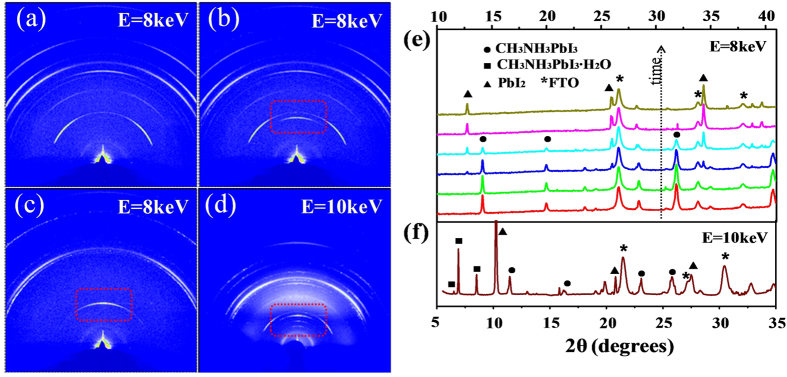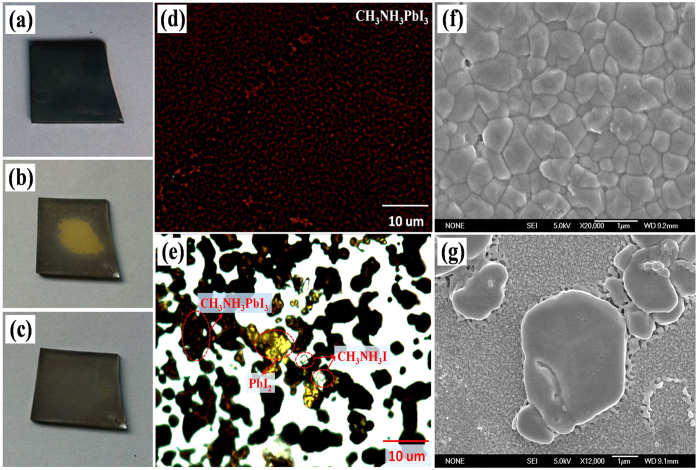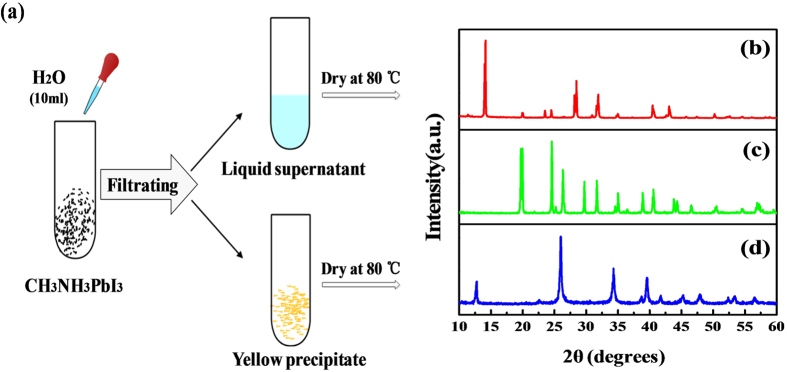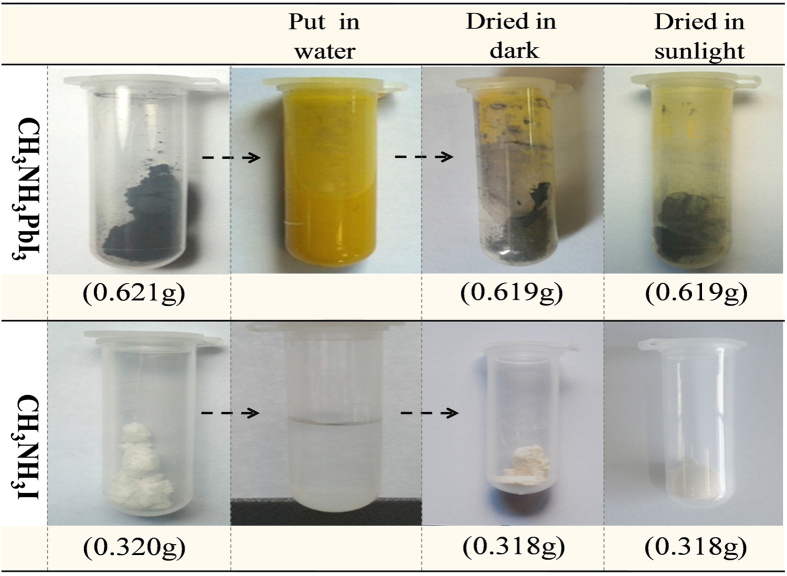Abstract
Instability of emerging perovskite organometallic halide in humidity environment is the biggest obstacle for its potential applications in solar energy harvest and electroluminescent display. Understanding the detailed decay mechanism of these materials in moisture is a critical step towards the final appropriate solutions. As a model study presented in this work, in situ synchrotron radiation x-ray diffraction was combined with microscopy and gravimetric analysis to study the degradation process of CH3NH3PbI3 in moisture, and the results reveal that: 1) intermediate monohydrated CH3NH3PbI3·H2O is detected in the degradation process of CH3NH3PbI3 and the final decomposition products are PbI2 and aqueous CH3NH3I; 2) the aqueous CH3NH3I could hardly further decompose into volatile CH3NH2, HI or I2; 3) the moisture disintegrate CH3NH3PbI3 and then alter the distribution of the decomposition products, which leads to an incompletely-reversible reaction of CH3NH3PbI3 hydrolysis and degrades the photoelectric properties. These findings further elucidate the picture of hydrolysis process of perovskite organometallic halide in humidity environment.
Nowadays, solar cells which use perovskite organometallic halide as light absorption layer have aroused a vast concern all over the world, due to the merits of high efficiency, low-cost and simple synthesis process of the perovskite materials1,2,3,4,5,6,7,8,9,10,11,12. In 2009, power conversion efficiency (PCE) of 3.81% was firstly demonstrated in perovskite solar cell with spin-coated CH3NH3PbI3 on FTO1. Six years later, PCE as high as ~20% has been acquired through continuous efforts in controlling the formation of the perovskite layer and choosing appropriate material for other layers2,3,4,5,6,7. The quickly enhanced PCE seems signal a new era of perovskite solar cells.
Unfortunately, the instability of organometallic halide perovskite in humidity environment is a tough problem, which hinders its practical application in solar cells and electroluminescent display. Therefore, it is urgent to make clear the decay mechanism of this easily air-slaked material, which is fundamentally meaningful and is also a critical step for pursuing more appropriate solutions. As a model system of perovskite organometallic halide, CH3NH3PbI3 has been intensively studied recently, including the instability problem in moisture13,14,15,16,17,18,19,20. For instance, in 2014, Niu and Frost et al proposed a set of degradation equations16 and a possible decomposition pathway17, respectively. Thereafter, more experimental evidences were reported by Yang18, Christians19 and Leguy20 et al. Yang and co-workers utilized in situ grazing incidence X-ray diffraction to monitor the phase evolution of CH3NH3PbI3 in water vapor, where an intermediate phase was found and supposed to be (CH3NH3)4PbI6 • 2H2O18. This intermediate phase was also discovered by Christians et al19. Moreover, Leguy et al reported a more systematic work performed with time-resolved XRD and ellipsometry, in which two different hydrated crystalline phases of CH3NH3PbI3, i.e., CH3NH3PbI3 • H2O and (CH3NH3)4PbI6 • 2H2O were detected and a suite of convincing degradation equations were provided20. However, despite all these, more detailed questions should be answered, like ‘what are the real final decomposition products?’ and ‘what is the function of moisture in the degradation process?’.
To address these issues, here, we carefully studied the degradation process of typical perovskite organometallic halide CH3NH3PbI3 in moisture. Using in-situ synchrotron XRD experiment, four distinct states have been revealed and in which monohydrated CH3NH3PbI3 • H2O and one decomposition product PbI2 are found. Another decomposition product, CH3NH3I, is confirmed through a solid-liquid separation experiment and it was demonstrated to be difficult for aqueous CH3NH3I to transform to volatile matter through a gravimetric analysis. The microscopy analysis reveals that the reaction of CH3NH3PbI3 with water vapor is not a completely reversible one, because the moisture alters the distribution of decomposition products and thus partially separates PbI2 and CH3NH3I.
Results and Discussion
In situ synchrotron radiation XRD experiment
Figure 1 is the schematic of the experiment setup, in which CH3NH3PbI3/FTO film was placed in a homemade sample cell at the diffractometer center. The relative humidity (RH) in the cell was controlled by tuning the flow rate of nitrogen gas and the temperature of the heater. The RH value was real-time monitored by a commercial hygrometer and which was regulated to about 80% during the whole experiment. To confine the moisture, the cell was sealed with kapton film which will not block the incident and diffractive x-ray beam passing through.
Figure 1. Schematic diagram of the RH control device and the diffraction geometry in the in-situ XRD experiment.
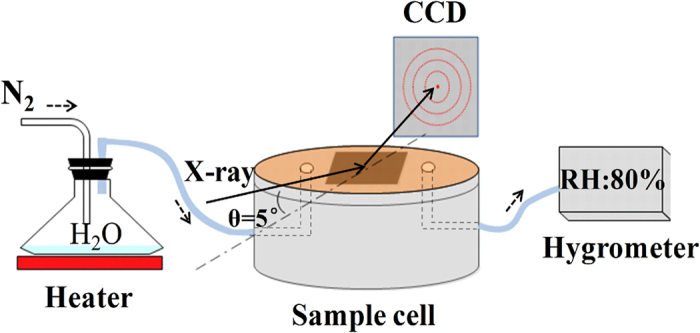
Figure 2 shows the typical diffraction patterns selected from the large set of data collected during the in situ synchrotron radiation XRD experiment, which indicates the degradation process of spin-coated CH3NH3PbI3/FTO in moisture.
Figure 2. In situ XRD patterns.
(a–d) Typical diffraction patterns of spin-coated CH3NH3PbI3/FTO in degradation process and (e–f) the corresponding integral curves obtained by using Fit2D program.
Figure 2a–c are three typical patterns taken during one test (X-ray photon energy E = 8keV) with a time sequence of a → b → c, and the corresponding integrated curves are presented in Fig. 2e among those belong to the time-serial data set. Figure 2a is the diffraction pattern of the as-grown CH3NH3PbI3/FTO without water vapor around the sample, which reveals that the film is polycrystalline with preferred orientation along the normal direction. As shown in Fig. 2b, with the time increasing in a relative humidity of 80 ± 5%, the diffraction peaks of perovskite CH3NH3PbI3 gradually decrease due to degradation and the reflections belonging to PbI2 (PDF#07-0235) become more and more intense. Figure 2c shows that the final decomposition product is composed mainly by PbI2. However, according to the law of conservation of elements, at least another decomposition product should be there. Since no obvious peaks from other phases appear in this pattern, that product is believed to be volatilized or dissolved in water. As described in detail in the following part, the product is proved to be aqueous CH3NH3I.
When we repeated the in situ XRD measurements, sometimes, we could fortunately detect a metastable phase during the degradation process. One of such patterns is presented in Fig. 2d and the integral curve is plotted in Fig. 2f. The peaks at 6.5°, 6.9° and 8.5° are ascribed to the (001), (110) and ( ) reflections of the metastable monoclinic CH3NH3PbI3·H2O20. Please note that such intermediate phases were not obvious every time during our XRD experiments, because it is difficult to catch these time- and space-limited phases without enough diffraction intensity by using x-ray beam with sub-millimeter size. Of course, it is more possible to detect such hydrates if people delay the degradation process by decreasing the relative humidity around the sample.
) reflections of the metastable monoclinic CH3NH3PbI3·H2O20. Please note that such intermediate phases were not obvious every time during our XRD experiments, because it is difficult to catch these time- and space-limited phases without enough diffraction intensity by using x-ray beam with sub-millimeter size. Of course, it is more possible to detect such hydrates if people delay the degradation process by decreasing the relative humidity around the sample.
Microscopy Analysis
During the in situ XRD experiment, the as-grown brown black CH3NH3PbI3/FTO film (Fig. 3a) gradually becomes yellow (Fig. 3b) in the humidity environment. But, it is interesting that the surface of the film slowly turns yellow to light black (Fig. 3c) after we take the film out of the humidity condition, which seems should be attributed to the water evaporating from the sample.
Figure 3. Microscopy images of CH3NH3PbI3/FTO film before and after decaying.
(a) Photographs of the as-grown CH3NH3PbI3/FTO film and (b,c) the decayed CH3NH3PbI3 films after taken out from the moisture. (d) Optical micrographs of the as-grown CH3NH3PbI3/FTO film and (e) the decayed CH3NH3PbI3 film. (f) SEM images of the as-grown CH3NH3PbI3/FTO film and (g) the decayed CH3NH3PbI3 film.
This phenomenon combined with XRD results (data not show here) indicates the reaction between CH3NH3PbI3 and water vapor is not fully reversible. We guess the underlying cause is that the water vapor not only decompose CH3NH3PbI3 into PbI2 and aqueous CH3NH3I, but also separates these products to some degree. To demonstrate this hypothesis, optic microscopy and scanning electron microscopy (SEM) were utilized to investigate the film morphology before and after the degradation.
Figure 3d is a typical optical micrograph of the as-grown spin-coated CH3NH3PbI3/FTO film. The uniform brown black color indicates the film is homogeneous without obvious second phase. Similar distribution state is also revealed from the corresponding SEM image (Fig. 3f). For the film after the degradation, three types of grain with different color could be easily recognized from the optical micrograph Fig. 3e. The yellow particles are PbI2, bright transparent grains should be CH3NH3I, and the brown black ones are the revived CH3NH3PbI3. In addition, the distribution of these color grains were found in an obvious isolated and disorder manner in comparison with the initial CH3NH3PbI3 film. The SEM image in Fig. 3g also clearly illustrates the rough morphology of the decayed CH3NH3PbI3 film. The above microscopy analysis proves that the moisture indeed alters the distribution of decomposition products and thus makes the reverse reaction between CH3NH3PbI3 and water insufficient.
Till now, the degradation process and decay mechanism may be expressed as follows:
 |
 |
Solid-Liquid Separation Methods and Gravimetric Analysis
As shown in the microscope images, the separation of PbI2 and CH3NH3I in real space is the key step towards the irreversible reaction between CH3NH3PbI3 and water. The cause of this separation is thought to be the different solubility of PbI2 and CH3NH3I in water, which is verified by the following solid-liquid separation experiment.
Here, CH3NH3PbI3 powder is used as the research object to make things simple and clear. The steps of the experiment are schematically shown in Fig. 4a. First, CH3NH3PbI3 powder (XRD pattern presented in Fig. 4b) was put in distilled water, and the black powder was found turned into yellow precipitate at once. Then, the liquid supernatant and the yellow precipitate were separated by centrifuging and filtrating. Both the liquid supernatant and yellow precipitate were dried at 80 °C in dark and the resulting powders were characterized by XRD (Fig. 4c,d), respectively.
Figure 4.
(a) Schematic diagram of solid-liquid separation experiment; XRD patterns of (b) CH3NH3PbI3 powder, (c) the resulting powder separated out from the liquid supernatant and (d) dried yellow precipitate.
From the XRD patterns, it is found that the soluble product of CH3NH3PbI3 hydrolysis is CH3NH3I (PDF#10-0737) and the yellow precipitate is PbI2 (PDF#07-0235). The difference in solubility of these two products is the major reason for separation.
Back to the aforementioned another question, i.e. ‘what are the real final decomposition products of CH3NH3PbI3 hydrolysis’, previous studies mostly claim that the final rest product is PbI2 while the aqueous CH3NH3I will volatilize as CH3NH2, HI or I2 in the condition of moisture and sunlight. Detailed information can be found in ref.16,17,21. Noted that CH3NH3PbI3/TiO2/FTO hetero-structure was used in these studies, it could not exclude the interfacial effect21 in CH3NH3PbI3/TiO2 since TiO2 is well-known photocatalytic material22. Therefore, another question emerged naturally is what the hydrolysis products of stand-alone CH3NH3PbI3. Here, a high-precision gravimetric analysis has been carried out to investigate whether the aqueous CH3NH3I will further volatilize for CH3NH3PbI3 powders, and the results are listed in Fig. 5. First, two sets of 0.621g CH3NH3PbI3 powder and two sets of 0.320g CH3NH3I powder were put in test tubes separately, and then 5 ml distilled water was injected in each test tube. Next, one set of watered CH3NH3PbI3 and one set of aqueous CH3NH3I were directly dried in dark, i.e. in the drying oven at 80 °C for a week, while the rest were dried in sunlight for the same time. Finally, all the dried powders were weighted using electronic balance with a precision of 0.01 mg.
Figure 5. Color and weight change of CH3NH3PbI3 (1st row) and CH3NH3I (2nd row) powder when dried in dark or sunlight.
The 1st row in Fig. 5 reveals the color and weight change of CH3NH3PbI3 powder in this experiment. Notice that the CH3NH3PbI3 decayed in water changes back to black again either dried in dark or in sunlight, which confirm that the reaction between CH3NH3PbI3 and water is almost reversible if the decomposition products are not separated. As shown by the weight values listed in the figure, the CH3NH3PbI3 powder almost does not loss any weight either dried in dark or in sunlight, which indicates that no obvious volatile matter release during CH3NH3PbI3 hydrolysis, i.e. it is hard for CH3NH3I to further separate. The conclusion was also verified by the control experiment performed on CH3NH3I powder, in which the results listed in the 2nd row show that the CH3NH3I powder weight almost does not reduce in any cases. In the above measurements, no reflections from other phases were detected by XRD before and after gravimetric analysis (data not shown here). Please note that, the results and conclusion presented here are much different from that found in CH3NH3PbI3/TiO2/FTO hetero-structure, indicating TiO2 could influence the degradation process of CH3NH3PbI3.
Now, it could be said that the above decay equations (1 and 2) are the major reaction for stand-alone CH3NH3PbI3, and the electric transport layer (ETL) in perovskite solar cells may affect the stability of perovskite organometallic hilides23,24,25,26. Our findings in this paper further elucidate the picture of hydrolysis process of this perovskite material in humidity environment.
Conclusion
Based on in situ synchrotron radiation XRD, a reasonable decomposition pathway for CH3NH3PbI3 materials in moisture is proposed and the intermediate monohydrated CH3NH3PbI3·H2O is detected during the degradation process. Moreover, the function of moisture was further investigated via microscopy and gravimetric analysis. The results show that moisture not only decompose CH3NH3PbI3 into PbI2 and aqueous CH3NH3I but also altered their distribution, which result in poor connection between PbI2 and CH3NH3I and thus leads to an incompletely-reversible reaction of CH3NH3PbI3 hydrolysis. Furthermore, it is confirmed that the final products of CH3NH3PbI3 hydrolysis are just PbI2 and aqueous CH3NH3I, and CH3NH3I will hardly further decompose into volatile CH3NH2, HI or I2 for CH3NH3PbI3 itself. The degradation process and decay mechanism of perovskite CH3NH3PbI3 in moisture becomes clearer with this work, which is believed to be helpful to understand the instability problem in moisture of various perovskite organometallic halides and figure out the possible solutions according to their applications.
Methods
To prepare the CH3NH3PbI3 specimens, equimolar CH3NH3I and PbI2 (98%, Sinopharm) were mixed in γ-butyrolactone (97%, Sinopharm) at 60 °C overnight whilst being stirred. Then, the aqueous precursor was deposited on FTO glass by spin-coating at 2000 rpm for 40s. Finally, the specimens were annealed at 100 °C for 15 min on a preheated hot plate, and the obtained CH3NH3PbI3/FTO films were brown black27.
In situ synchrotron radiation XRD was performed at the BL14B station of Shanghai Synchrotron Radiation Facility (SSRF), and the experimental setup is schematically shown in Fig. 1. The diffractive patterns were recorded by a two-dimension x-ray detector (charge coupled device, CCD) with 3072 × 3072 pixels. To monitor the reaction at real-time, the diffraction patterns were continuously recorded with 10 seconds per frame and 1 second between adjacent frames.
To investigate the CH3NH3PbI3 film morphology before/after the reaction, microscopy analysis was performed by using optical microscope (OLYMPUS, BX51) and scanning electron microscope (SEM, JSM-6700F).
Additional Information
How to cite this article: Zhao, J. et al. Investigation of the Hydrolysis of Perovskite Organometallic Halide CH3NH3PbI3 in Humidity Environment. Sci. Rep. 6, 21976; doi: 10.1038/srep21976 (2016).
Acknowledgments
The authors thank the staff at beamline BL14B of SSRF for their support. This work was financially supported by the National Natural Science Foundation of China (11374010 and 11434009) and the Fundamental Research Funds for the Central Universities.
Footnotes
Author Contributions J.Z. and Z.L. designed the experiment. B.C. and W.Z. carried out synthesis of materials. J.Z., Z.L., Y.D., H.X. and C.G. performed the in situ XRD experiment and data analysis. Microscopy analysis and the rest experiment were performed by B.H., Y.Z., Y.Y. and L.L. The paper was written by J.Z and Z.L. All authors reviewed and commented on the manuscript.
References
- Kokima A., Teshima K., Shirai Y. & Miyasaka. Organometal halide perovskites as visible-light sensitizers for photovoltaic cells. J. Am. Chem. Soc. 131, 6050–6051 (2009). [DOI] [PubMed] [Google Scholar]
- Im J. H., Lee C. R., Lee J. W., Park S. W. & Park N. G. 6.5% efficient perovskite quantum-dot-sensitized solar cell. Nanoscale 3, 4088–4093 (2011). [DOI] [PubMed] [Google Scholar]
- Kim H. S. et al. Lead iodide perovskite sensitized all-solid-state submicron thin film mesoscopic solar cell with efficiency exceeding 9%. Sci. Rep. 2, 591, doi: 10.1038/srep00591 (2012). [DOI] [PMC free article] [PubMed] [Google Scholar]
- Liu M. Z., Johnston M. B. & Snaith H. J. Efficient planar heterojunction perovskite solar cells by vapour deposition. Nature 501, 395–398 (2013). [DOI] [PubMed] [Google Scholar]
- Jeon N. J. et al. Solvent engineering for high-performance inorganic–organic hybrid perovskite solar cells. Nature materials 13, 897–903 (2014). [DOI] [PubMed] [Google Scholar]
- Zhou H. P. et al. Interface engineering of highly efficient perovskite solar cells. Science 345,542–546 (2014). [DOI] [PubMed] [Google Scholar]
- Best Research cells efficiencies. http://www.nrel.gov/ncpv/images/efficiency_chart.jpg, Date of access: 30/12/2014.
- Saidaminov M. I. et al. High-quality bulk Hybrid perovskite single crystals within minutes by inverse temperature crystallization. Nat. Commun. 6, 7586, doi: 10.1038/ncomms8586 (2015). [DOI] [PMC free article] [PubMed] [Google Scholar]
- Dong Q. F. et al. Electron-hole diffusion lengths >175 um in solution-grown CH3NH3PbI3 single crystals. Science 347, 967–970 (2015). [DOI] [PubMed] [Google Scholar]
- Dou L. T. et al. Atomically thin two-dimenstional organic-inorganin hybrid perovskites. Science 349, 1518- 1521 (2015). [DOI] [PubMed] [Google Scholar]
- Liu Y. C. et al. Two-Inch-Sized perovskite CH3NH3PbX3 (X = Cl, Br, I) crystals: growth and characterization. Adv. Mater. 27, 5176–5183 (2015). [DOI] [PubMed] [Google Scholar]
- Wong A. B. et al. Growth and anion exchange conversion of CH3NH3PbX3 nanorod arrays for light-emitting diodes. Nano Lett. 15, 5519–5524 (2015). [DOI] [PubMed] [Google Scholar]
- GRÄTZEL M. & Park N. G. Organometal halide perovskite photovoltaics: A diamond in the rough. Nano 09, 1440002, doi: 10.1142/S1793292014400025 (2014). [DOI] [Google Scholar]
- Niu G. D., Guo X. D. & Wang L. D. Review of recent progress in chemical stability of perovskite solar cells. J. Mater. Chem. A 3, 8970–8980 (2015). [Google Scholar]
- Dong X. et al. Improvement of the humidity stability of organic–inorganic perovskite solar cells using ultrathin Al2O3 layers prepared by atomic layer deposition. J. Mater. Chem. A 3, 5360–5367 (2015). [Google Scholar]
- Niu G. D. et al. Study on the stability of CH3NH3PbI3 films and the effect of post-modification by aluminum oxide in all-solid-state hybrid solar cells. J. Mater. Chem. A 2, 705–710 (2014). [Google Scholar]
- Frost J. M. et al. Atomistic origins of high-performance in hybrid halide perovskite solar cells. Nano Lett. 14, 2584–2590 (2014). [DOI] [PMC free article] [PubMed] [Google Scholar]
- Yang J. L., Siempelkamp B. D., Liu D. Y. & Kelly T. L. Investigation of CH3NH3PbI3 degradation rates and mechanisms in controlled humidity environments using in situ techniques. ACS Nano 9, 1955–1963 (2015). [DOI] [PubMed] [Google Scholar]
- Christians J. A., Miranda Herrera P. A. & Kamat P. V. Transformation of The Excited State and Photovoltaic Efficiency of CH3NH3PbI3 Perovskite upon Controlled Exposure to Humidified Air. J. Am. Chem. Soc. 137, 1530–1538 (2015). [DOI] [PubMed] [Google Scholar]
- Leguy A. M. A. et al. Reversible Hydration of CH3NH3PbI3 in films, Single Crystals and Solar Cells. Chem. Mater. 27, 3397–3407 (2015). [Google Scholar]
- Ito S., Tanaka S., Manabe K. & Nishino H. Effects of surface blocking layer of Sb2S3 on nanocrystalline TiO2 for CH3NH3PbI3 perovskite solar cells. J. Phys. Chem. C 118, 16995–17000 (2014). [Google Scholar]
- Chen X. B. & Mao S. S. Titanium dioxide nanomaterials: synthesis, properties, modifications and applications. Chem. Rev. 107, 2891–2959 (2007). [DOI] [PubMed] [Google Scholar]
- Mali S. S., Shim C. S. & Hong C. K. Highly porous zinc stannate(Zn2SnO4) nanofibers scaffold photoelectrodes for efficient methyl ammonium halide perovskite solar cells. Sci. Rep. 5, 11424, doi: 10.1038/srep11424 (2015). [DOI] [PMC free article] [PubMed] [Google Scholar]
- Bera A. et al. Fast crystallization and improved stability of perovskite solar cells with Zn2SnO4 electron transporting layer: interface matters. ACS Appl. Mater. Interfaces 7, 28404–28411 (2015). [DOI] [PubMed] [Google Scholar]
- Mali S. S. et al. Ultrathin atomic layer deposited TiO2 for surface passivation of hydrothermally grown 1D TiO2 nanorod arrays for efficient solid-state perovskite solar cells. Chem. Mater. 17, 1541–1551 (2015). [Google Scholar]
- You J. B. et al. Improved air stability of perovskite solar cells via solution-processed metal oxide transport layers. Nature Nanotech. 11, 75–81(2016). [DOI] [PubMed] [Google Scholar]
- Cai B., Xing Y. D., Yang Z., Zhang W. H. & Qiu J. S. High performance hybrid solar cells sensitized by organolead halide perovskites. Energy Environ. Sci. 6, 1480–1485 (2013). [Google Scholar]



